
I’ve got some blind spots in CSS-related performance things. One example is the will-change property. It’s a good name. You’re telling the browser some particular property (or the scroll-position or content) uh, will, change:
.el { will-change: opacity;
}
.el.additional-hard-to-know-state { opacity: 0;
}But is that important to do? I don’t know. The point, as I understand it, is that it will kick .el into processing/rendering/painting on the the idea pile. But my point is that there are things in CSS that are designed explicitly for performance that are confusing to me, and I wish I had a more full understanding of them because they seem like Very Big Deals.
Take “How I made Google’s data grid scroll 10x faster with one line of CSS” by Johan Isaksson. A 10✕ scrolling performance improvement is a massive deal! Know how they fixed it?
[…] as I was browsing the “Top linking sites” page I noticed major scroll lag. This happens when choosing to display a larger dataset (500 rows) instead of the default 10 results.
[…]
So, what did I do? I simply added a single line of CSS to the
<table>on theElementspanel, specifying that it will not affect the layout or style of other elements on the page
table { contain: strict; }The contain property is another that I sort of get, but I’d still call it a blind spot because my brain doesn’t just automatically think of when I could (or should?) use it. But that’s a bummer, because clearly I’m not building interfaces as performant as I could be if I did understand contain better.
There’s another! The content-visibility property. The closest I came to understanding it was after watching Jake and Surma’s video on it where they used it (along with contain-intrinsic-size and some odd magic numbers) to dramatically speed up a long page. What hasn’t stuck with me is when I should use it on my pages.
Are all three of these features “there if you need them” features? Is it OK to ignore them until you notice poor performance on something (like a massive page) and then reach for them to attempt to solve it? Almost “don’t use these until you need them,” otherwise you’re in premature optimization territory. The trouble with that is the classic situation where you won’t actually notice the poor performance unless you are very actively testing on the lowest-specced devices out there.
Or are these features “this is what modern CSS is and you should be thinking of them like you think of padding” territory? I kind of suspect it’s more like that. If you’re building an element you know won’t change in certain ways, it’s probably worth “containing” it. If you’re building an element you know will change in certain ways, it’s probably worth providing that info to browsers. If you’re building a part of page you know is always below the fold, it’s probably worth avoiding the paint on it. But personally, I just don’t have enough of this fully grokked to offer any solid advice.






